The case interview is the ultimate challenge for most consulting candidates. Whether you’re just starting your preparation or you are 30 practice cases in, it’s always helpful to familiarize yourself with the most popular case interview frameworks. However, the goal is not to memorize the case study interview frameworks. You must understand each well enough to know when they apply and how to blend them to create your own frameworks.
It's always a red flag for an interviewer if a candidate tries to improperly cram a business situation into a framework. Instead, you need to know how to mix and match across the framework categories to create your own custom approach to solve the problem at hand. Enjoy this breakdown of case study interview frameworks - and apply wisely!
Again, always remember that the best candidates create unique frameworks for each of their cases. When you are structuring your thoughts during a case interview, pick and choose the relevant parts of these frameworks that you think will help solve your client’s problem. The best case interview frameworks are the ones that will help you solve your client's problem.

Use Of Case Interview Frameworks
In this and the following articles (links at the end), we will give an overview of the frameworks we use both for interviews and on-the-job at MC. We'll cover what they are and how you can get to know them well enough to use them. In the subsequent articles, we’ll explore each one in more detail.
For each framework, we will give you:
- Knowledge of the underlying business concepts
- The questions they are supposed to address
- How to identify when to use them in a case
- How to best deliver them
- How to apply them creatively
Why Case Interview Frameworks Matter
If you've heard about different frameworks from different places, why should you care about these?
- Our frameworks enable you to solve absolutely every case, so make sure you understand them in depth.
- The frameworks are useful for real-life consulting projects, not just sterile academic case-prepping.
- You could memorize 12 or 15 or 20 frameworks, but you will not gain expertise in any if you try to use all.
- The frameworks can be mixed and matched; a combo may in fact be the only way to solve the case.
- Remember, these are not comprehensive tools. If you understand how to properly use the concepts in these cases, you will be able to solve any case that is put in front of you.
How To Use Case Interview Frameworks (And How Not To)
Before we give you the intro to case frameworks, here are some guidelines for how best to use them:
- Don’t expect to be given a question that only draws from one of the frameworks. It may well be that you have to borrow from all 4 to break the case down effectively.
- Listen to the question carefully so you can know which framework(s) to use.
- If you don't know for sure, pick one (profitability is a classic go-to) and just get started.
- Be ready for a change of direction! You may be using one framework after the opening, only to have the interviewer ask you a question part way through that allows you to change to another one.
- Do not use the word “framework” in your interview. The moment you use that word, you’re telling the interviewer that you’re going to fit the case into a previously memorized set of rules. Strict rigidity is not your friend.
Frameworks are only a starting point. Remember, this is an intro to case frameworks. These frameworks are really good at helping you come to grips with the concepts being presented. Once you understand what is being asked, adjust them to the case at hand.
[optin-monster slug="fadl1lf9l0hl8h0cmmkr" followrules="true"]
Common Case Interview Frameworks:
-
The Profitability Framework
Ultimately, a corporation’s goal is to increase profits. Profits may also be important goals for governments and institutions as well. As a result, profitability remains one of the most common objectives in consulting case study interviews. Knowing how to analyze the major components of profitability is imperative for any aspiring consultant.
The profitability framework is mainly broken into two components: revenue and costs. A profitability view requires looking into both components. Within each of these components, you can structure your framework to analyze the drivers within (price, quantity, variable costs and fixed costs) or the overall situation (big picture and potential solutions).
Additionally, there will be times when your case interviewer states that your client is focused (specifically) on increasing revenue or decreasing costs. You may be tempted to always look at both revenue and costs, but there are many instances when the case is built around only one of those categories. Pay close attention when your interviewer gives you a nudge in the prompt or when answering clarifying questions, and stay laser focused on what the client needs.
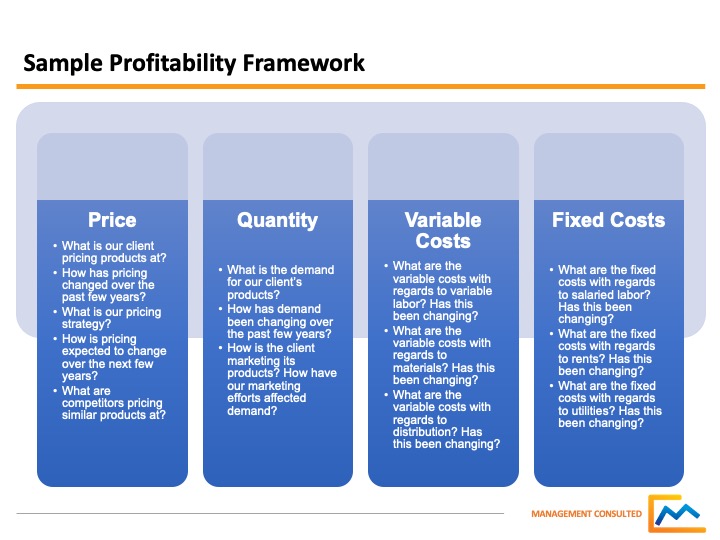
Download the Profitability Framework Example here.
Potential Profitability Framework Categories and Questions:
Revenue
Price
- What is our client pricing its products at?
- How has pricing changed over the past few years?
- What is our pricing strategy?
- How is pricing expected to change over the next few years?
- What are competitors pricing similar products at?
Quantity
- What is the demand of our client’s products?
- How has demand been changing over the past few years?
- How is the client marketing its products? How have our marketing efforts affected demand?
Big Picture
- What are our client’s revenue streams?
- What percent of total revenue does each stream represent?
- Have those percentages changed lately?
- Have the revenue streams been declining or growing over the past 1, 3, 5, or 10 years?
- How is our client growing relative to the industry?
- What is our market share in terms of sales compared to competitors?
Ways to Increase Revenue
- Increase prices
- Update marketing strategy
- Bundle products
Cost
Variable Costs
- What are the variable costs with regards to variable labor? Has this been changing?
- What are the variable costs with regards to materials? Has this been changing?
- What are the variable costs with regards to distribution? Has this been changing?
Fixed Costs
- What are the fixed costs with regards to salaried labor? Has this been changing?
- What are the fixed costs with regards to rents? Has this been changing?
- What are the fixed costs with regards to utilities? Has this been changing?
Big Picture
- What are the client’s major fixed and variable costs?
- How have costs changed over the past few years?
- How are our client’s relationships with its suppliers?
- Will reducing costs damage any of our revenue streams?
- How do our costs compare against our competitors?
- What does our client’s supply chain look like?
- Is there anything happening within our client’s market or the economy that is impacting costs?
- Are there any government regulations that impact our client’s costs?
Ways to Decrease Costs
- Analyze areas of the business that aren’t producing results and reduce resources
- Create a more efficient supply chain
- Negotiate with suppliers for lower costs
Join an Upcoming Case Interview Event
[tribe_events_list category="consulting-prep" limit ="3"]
-
The Pricing Framework
Another common case study interview framework revolves around pricing strategy. Generally, prices greatly impact volume and ultimately profits, so this case study objective comes up frequently.
Pricing products and services is a great challenge for companies because prices greatly influence customer decisions. Consulting firms with rich histories and long track records can utilize their work with similar previous clients to provide the guidance needed to get the most out of current clients' pricing strategies.
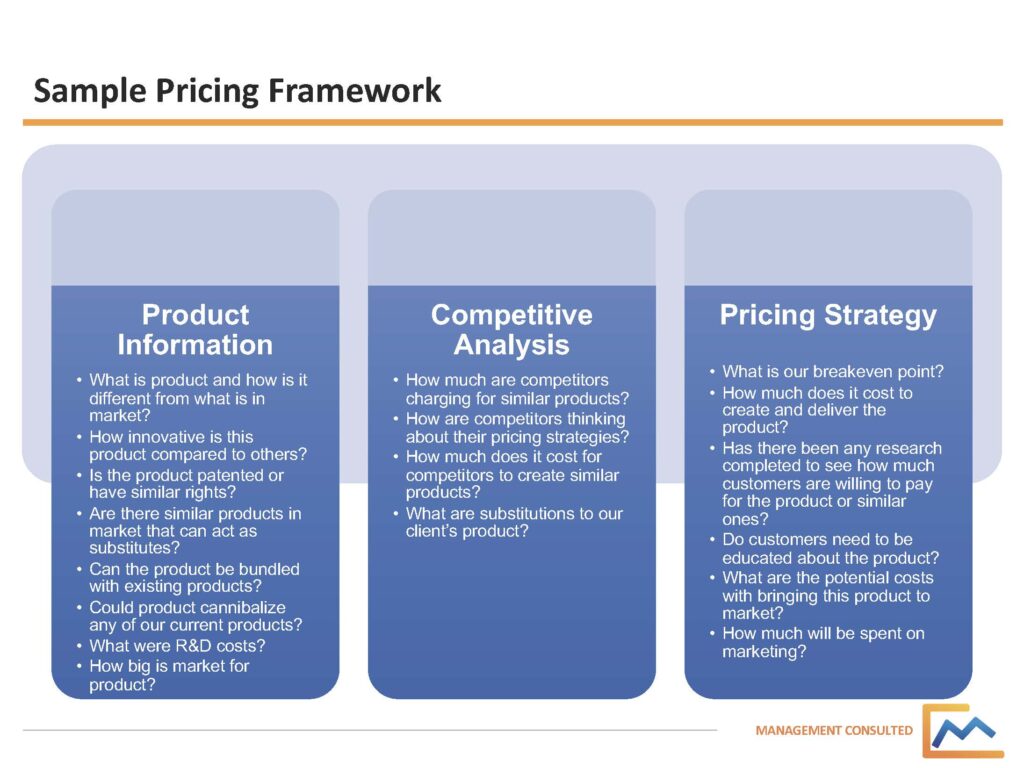
Download the Pricing Framework Example here.
Potential Pricing Framework Categories and Questions:
Product Information
- What is the product and how is it different from what is currently on the market?
- How innovative is this product compared to others that exist in the market?
- Is the product patented or have any rights that can protect it from being copied?
- Are there similar products in the market that can act as substitutes?
- Can the product be bundled with any existing products?
- Could the product cannibalize any of the client’s current products?
- What were the R&D costs required to create this product?
- How big is the market for this product?
Competitive Analysis
- How much are competitors charging for similar products?
- How are competitors thinking about their pricing strategies?
- How much does it cost for competitors to create similar products?
- What are substitutions to our client’s product?
Pricing Strategy
- What is our breakeven point?
- How much does it cost to create and deliver the product?
- Has there been any research completed to see how much customers are willing to pay for the product or similar ones?
- Do customers need to be educated about the product?
- What are the potential costs with bringing this product to market?
- How much will be spent on marketing?
The 3 C's + Business Situation Framework
The 3C's and business situation framework overlap in categories, so they will be combined in this section. Both case interview frameworks are focused on broad business categories that could be the source of a client’s problem.
The 3Cs focus on the Company, Customers, and Competition. The business situation framework, coined by Victor Cheng, adds Products as an additional category. This combination of categories makes sense with a case involving a focus on understanding both the core elements of the client as well as the competitive landscape.

Download the 3 Cs Framework Example here.
Potential 3 C's Framework Categories and Questions:
Company
- What defines the company?
- What are the company’s core competencies?
- How long has the company been around?
- What do the company’s financial performance look like over the past few years?
- What is the company’s management team like?
- How strong is our company’s brand?
- What are our client’s competitive advantages? What are our client’s weaknesses?
Customers
- Who is the customer?
- What are the customer demographics?
- How are customers segmented? What kind of growth have each of these segments seen over the past few years? How are they projected to grow?
- How sensitive are customers to prices?
- What are the distribution channels through which the client reaches its customers?
Competition
- Who are the competitors in the market and what is their market share?
- How quickly is each competitor growing?
- Do our competitors offer products or services that our client does not?
- How is the competition marketing their products?
- How is the competition pricing their products?
Product
- What products does the client offer? What is the client’s product mix?
- How innovative is this product compared to others that exist in the market?
- Is the product patented or have any rights that can protect it from being copied?
- Are there similar products in the market that can act as substitutes?
- Can the product be bundled with any existing products?
- How big is the market for this product?
-
The 4 P's
The 4P's is a common case interview framework used to structure thoughts on marketing strategy. This framework is often used when a new product is launched or when reviewing existing products.
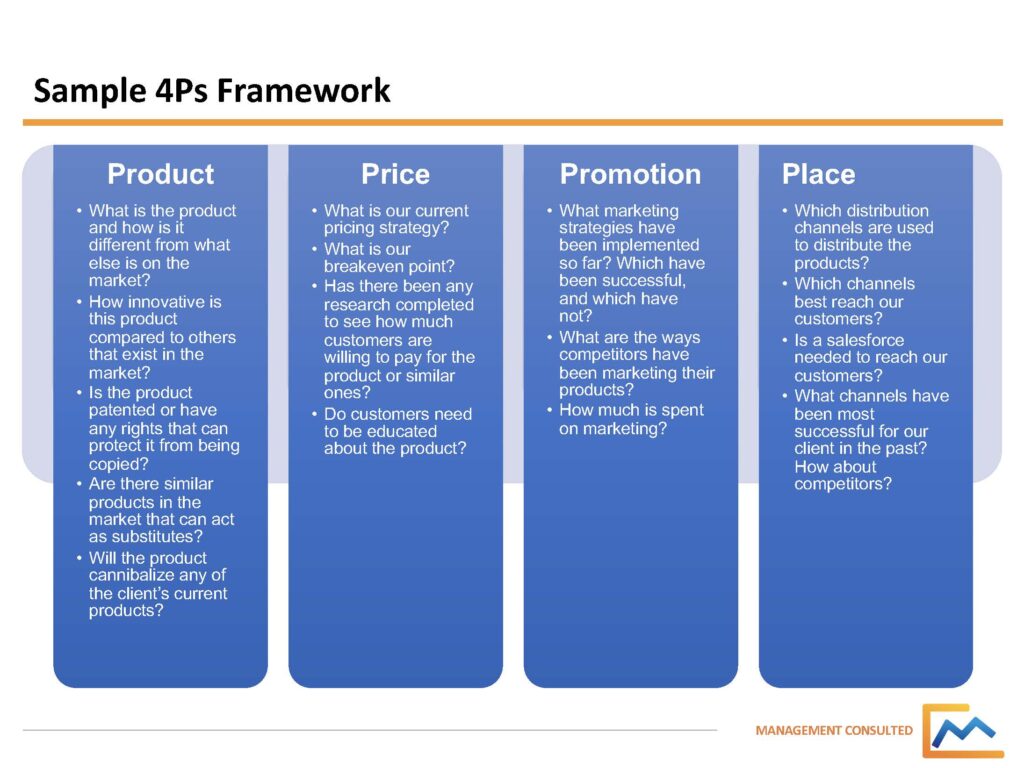
Download the 4 Ps Framework Example here.
Potential 4 P's Framework Categories and Questions:
Product
- What is the product and how is it different from what else is on the market?
- How innovative is this product compared to others that exist in the market?
- Is the product patented or have any rights that can protect it from being copied?
- Are there similar products in the market that can act as substitutes?
- Will the product cannibalize any of the client’s current products?
Price
- What is our current pricing strategy?
- What is our breakeven point?
- Has there been any research completed to see how much customers are willing to pay for the product or similar ones?
- Do customers need to be educated about the product?
Promotion
- What marketing strategies have been implemented so far? Which have been successful, and which have not?
- What are the ways competitors have been marketing their products?
- How much is spent on marketing?
Place
- Which distribution channels are used to distribute the products?
- Which channels best reach our customers?
- Is a salesforce needed to reach our customers?
- What channels have been most successful for our client in the past? How about competitors?
-
Porter's 5 Forces
Porter’s Five Forces is one of the most well known business frameworks in the world. Named after its founder, Michael Porter, the tool provides a structured way of analyzing an industry and understanding how companies fit into the overall competitive picture.
The Porter’s Five Forces model focuses on five undeniable factors that shape a market, regardless of the industry the company is in. Studying these forces can allow consultants to understand how competitive, attractive, and profitable an industry may be.
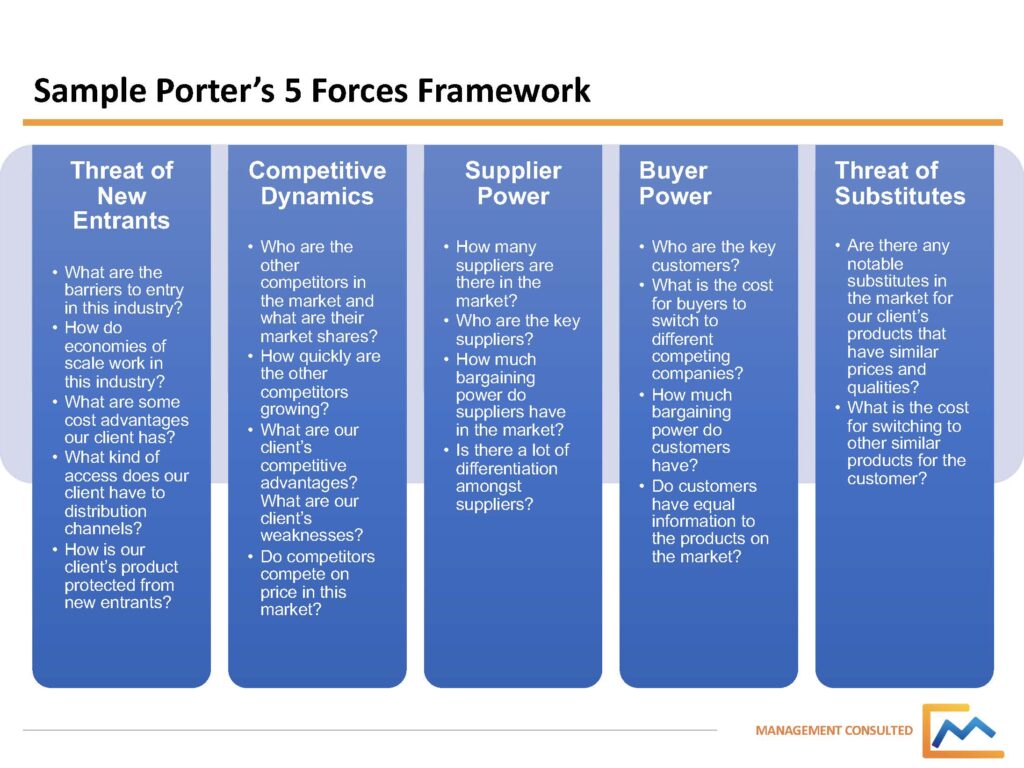
Download the Porters 5 Forces Framework Example here.
Potential Porter's 5 Forces Framework Categories and Questions:
Threat of New Entrants
- What are the barriers to entry in this industry?
- How do economies of scale work in this industry?
- What are some cost advantages our client has?
- What kind of access does our client have to distribution channels?
- How is our client’s product protected from new entrants?
Competitive Dynamics
- Who are the other competitors in the market and what are their market shares?
- How quickly are the other competitors growing?
- What are our client’s competitive advantages? What are our client’s weaknesses?
- Do competitors compete on price in this market?
Supplier Power
- How many suppliers are there in the market?
- Who are the key suppliers?
- How much bargaining power do suppliers have in the market?
- Is there a lot of differentiation amongst suppliers?
Buyer Power
- Who are the key customers?
- What is the cost for buyers to switch to different competing companies?
- How much bargaining power do customers have?
- Do customers have equal information to the products on the market?
Threat of Substitutes
- Are there any notable substitutes in the market for our client’s products that have similar prices and qualities?
- What is the cost for switching to other similar products for the customer?
-
Market Entry Framework
Companies often need to enter new markets to grow their businesses. This is exciting for businesses because new markets represent new opportunities, but of course, more challenges.
Case study interview frameworks for new markets should first include categories and questions that are open-ended, since there are a wide range of possibilities. Once you have a better idea of where the case is going based on the data and information you’re provided, drill into those categories.
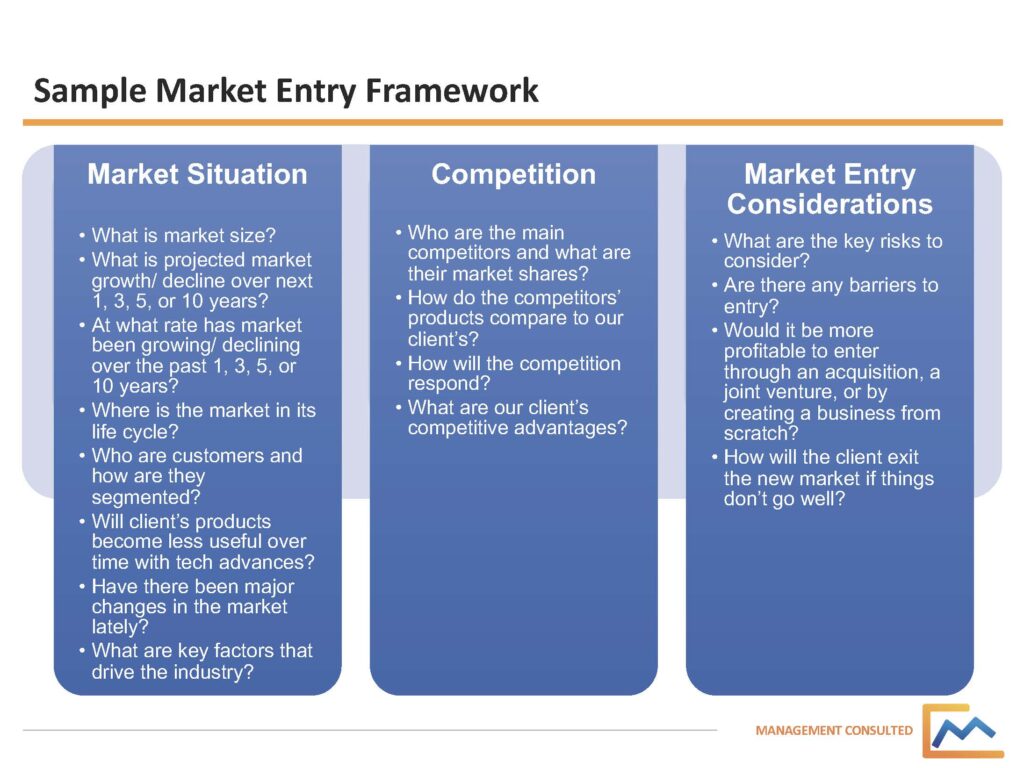
Download the Market Entry Framework Example here.
Potential Market Entry Framework Categories and Questions:
Market Situation
- What is the size of the market?
- What is the projected market growth or decline over the next 1, 3, 5, or 10 years?
- At what rate has the market been growing or declining over the past 1, 3, 5, or 10 years?
- Where is the market in its life cycle?
- Who are the customers and how are they segmented?
- Will our client’s products become less useful over time with technological advances?
- Have there been any major changes in the market lately?
- What are the key factors that drive the industry?
Competition
- Who are the main competitors and what are their market shares?
- How do the competitors’ products compare to our client’s?
- How will the competition respond?
- What are our client’s competitive advantages?
Market Entry Considerations
- What are the key risks to consider?
- Are there any barriers to entry?
- Would it be more profitable to enter through an acquisition, a joint venture, or by creating a business from scratch?
- How will the client exit the new market if things don’t go well?
-
New Product Framework
Like entering new markets, companies need to develop new products to grow. This problem is intimidating for clients due to potential high costs and fear of the unknown. Your case study interview framework should dive deep into the new product before anything else.
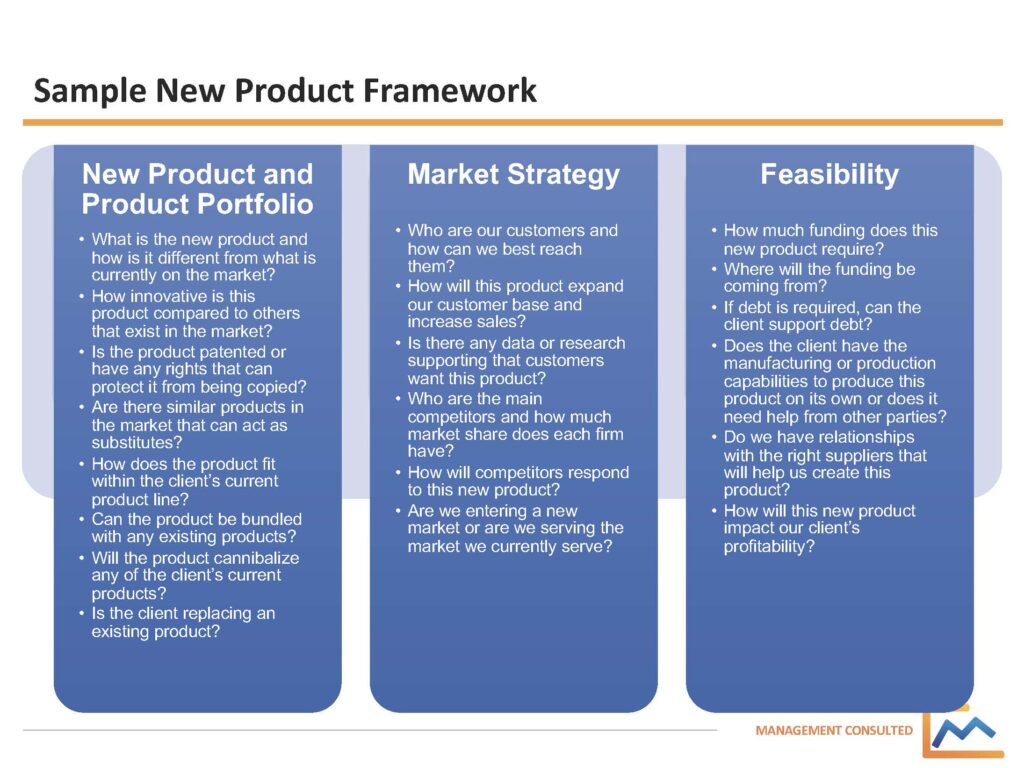
Download the New Product Framework Example here.
Potential New Product Framework Categories and Questions:
New Product and Product Portfolio
- What is the new product and how is it different from what is currently on the market?
- How innovative is this product compared to others that exist in the market?
- Is the product patented or have any rights that can protect it from being copied?
- Are there similar products in the market that can act as substitutes?
- How does the product fit within the client’s current product line?
- Can the product be bundled with any existing products?
- Will the product cannibalize any of the client’s current products?
- Is the client replacing an existing product?
Market Strategy
- Who are our customers and how can we best reach them?
- How will this product expand our customer base and increase sales?
- Is there any data or research supporting that customers want this product?
- Who are the main competitors and how much market share does each firm have?
- How will competitors respond to this new product?
- Are we entering a new market or are we serving the market we currently serve?
Feasibility
- How much funding does this new product require?
- Where will the funding be coming from?
- If debt is required, can the client support debt?
- Does the client have the manufacturing or production capabilities to produce this product on its own or does it need help from other parties?
- Do we have relationships with the right suppliers that will help us create this product?
- How will this new product impact our client’s profitability?
-
M&A (Mergers and Acquisitions) Framework
Because they aren’t as common, mergers and acquisitions (M&A) problems often can catch candidates off guard in case interviews. Though you aren’t recruiting for a finance position, it’s still important to have a decent understanding of what M&A case interview frameworks should focus on.
Additionally, a potential merger or acquisition may be a small part of a larger case. For instance, if the company wants to grow, an option the client could be considering is acquiring a smaller competitor. In this case, it will be important for you to be able to structure an M&A framework to systematically discover if this is a good idea for your client.
The first key to nailing an M&A framework question is to understand who the acquirer is. All different types of firms will want to increase cash flow. But the type of acquirer will determine how long of an investment they want to make. Look at the types of acquirers that would influence the term of the investment:
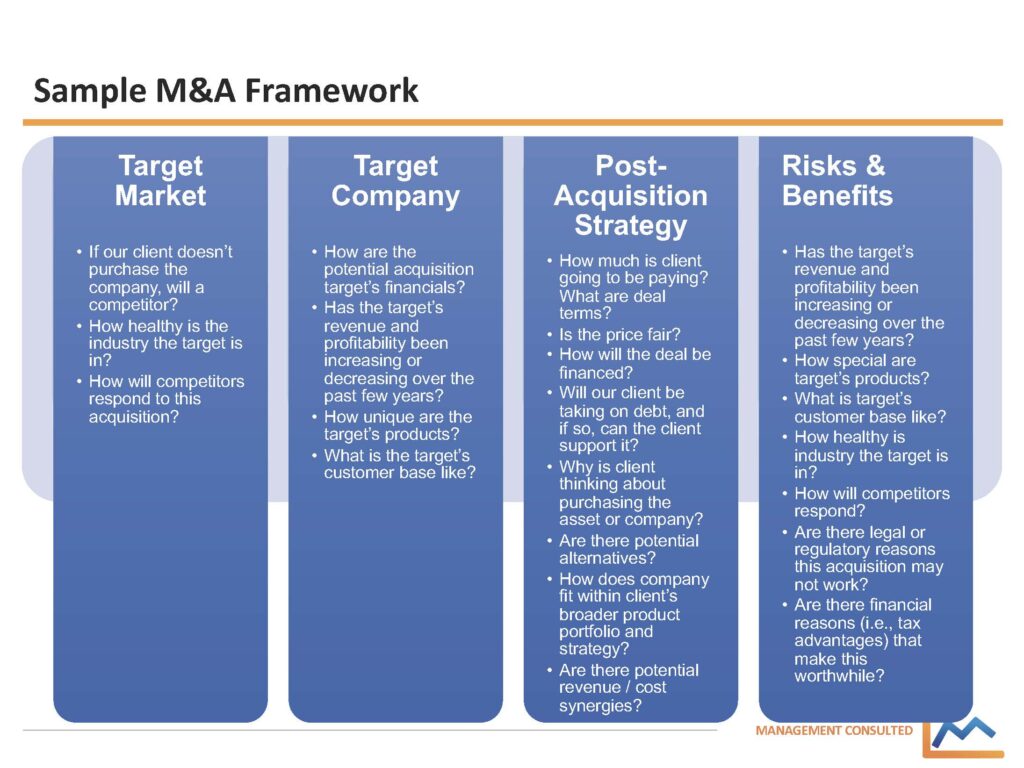
Download the M&A Framework Example here.
Types of M&A Acquirers:
Financial Acquirer- e.g., PE Firm
100% ownership. Typically, the goal would be to sell the company for a quick return. They’ll usually do this by rapidly decreasing costs and increase top-line revenues and profits with cash injections. They’re not looking for a long-term investment.
Financial Investor- e.g., Hedge Fund
Non-majority owner. The goal is that their involvement would positively affect the share value. Once that takes place, they would look to sell the shares for a profit.
Corporate Acquirer- e.g., Multinational Firm
100% ownership. Typically, these types of acquirers will operate the purchased company for a period of time. Additionally, they may have bought the company for a specific purpose and integrate it into their overall company operations.
How To Use The M&A Framework:
With M&A frameworks, remember this key concept. Most of the time, interviews are going to be focused on due diligence strategy. They are looking to understand if one company should buy or invest in another. Look at these 4 key areas:
-
The Target Market
What is the market like? Is it saturated with competitors? Is the market growing, stagnant, or contracting- and why? Obviously, investors are looking for attractive markets. Typically, one of the biggest questions to answer is whether the overall market is big enough for your client’s end goals.
-
The Target Company
This is all about helping your client understand not only if the market is right, but if the company they are looking at buying is the best target company within that market. So you must understand everything about the target company. What are their finances like? Do they have strong profits? What do their forecasts look like? What is their competitive positioning? Are they a top performer, generating strong revenues, or do they have room for improvement with the potential to gain significant market share?
-
Post-Acquisition Strategy
This is really about understanding your clients goals and objectives for the investment, plus how much your client could make over time. The market and the company valuations help you understand how much your client should pay for the target company. So the post-acquisition strategy ties the first two sections together, and also send the message that things will change post purchase..
Is there potential to decrease costs in the target company and increase revenues? Is the culture of the target company conducive to integrating into the purchasing company? Questions like these need to be answered to better understand if the target company would be a beneficial acquisition.
-
Risks and Benefits
Risks and benefits can be a bit more difficult to determine. For example, does the target company have intangible assets, like Intellectual Property? How do you determine the value of their IP? Or what about their management team? Does their management have the capacity to take the company where it needs to go? Are there government restrictions or litigation that they’re experiencing? These types of questions have to be quantified in order for your client to understand if the target company is actually a good value and something that they want to take on.
One bright spot in M&A frameworks is that the recommendations are typically one of the easiest to create because it’s ultimately a yes or no question. And if your answer is yes, your recommendation should be strong and direct! Take a look at our article on the Pyramid Principle to see how to present your recommendation like executives would want it. If you are against the investment then have your details ready as to why not… again, in the Pyramid Principle format. Have your compelling supporting data ready to share, if asked for.
Potential M&A Framework Categories and Questions:
Target Market
- If our client doesn’t purchase the company, will a competitor?
- How healthy is the industry the target is in?
- How will competitors respond to this acquisition?
Target Company
- How are the potential acquisition target’s financials?
- Has the target’s revenue and profitability been increasing or decreasing over the past few years?
- How unique are the target’s products?
- What is the target’s customer base like?
Post-Acquisition Strategy
- How much is our client going to be paying? What are the terms of the deal?
- Is the price fair?
- How will the deal be financed?
- Will our client be taking on debt, and if so, can the client support it?
- Why is our client thinking about purchasing the asset or company?
- Are there any potential alternatives?
- How does the company fit within our client’s broader product portfolio and strategy?
- Are there a lot of potential revenue and cost synergies from the deal?
Risks & Benefits
- How are the potential acquisition target’s financials?
- Has the target’s revenue and profitability been increasing or decreasing over the past few years?
- How special are the target’s products?
- What is the target’s customer base like?
- How healthy is the industry the target is in?
- How will competitors respond to this acquisition?
- Are there any legal or regulatory reasons this acquisition may not work?
- Are there any financial reasons like tax advantages that make this a good transaction?
Case Interview Frameworks Cheat Sheet
For your convenience, we've created a Case Interview Frameworks Cheat Sheet that you can download here. We trust that you'll find this helpful in your case interview prep. Feel free to share it with others.
Free Case Interview Prep Course
MC has a free Case Interview Prep Course! This course will give you a solid foundation on which to build the rest of your preparation. Get started today.
Case Interview Frameworks Overview Video
Conclusion
Case interview frameworks are great to quickly assess specific business situations. Yet, they each have their limitations and proper uses. Remember, the best case interview frameworks are the ones that allow a good result for you client. Don't try to force the framework for the sake of using a framework. Be creative and mix and match the frameworks based on the problem given to show your business acumen.
We trust that our list of case interview frameworks were beneficial to that end. If you want to know how to apply the case frameworks, blend them, and build your own, reach out for expert coaching. Good luck in your interview!